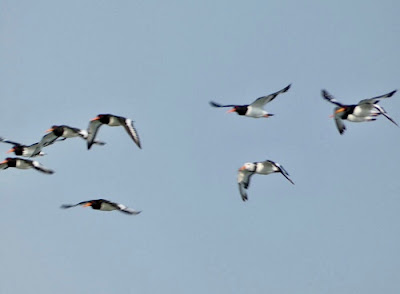East to NE light wind, but again occasionally swirling around to NNW towards the harbour entrance. Hot sunshine.
First, Pete Crooks has received the history for one of the colour ringed Oystercatcher he read on Thursday:
A prompt reply from the Devon & Cornwall Wader Ringing Group about one of the c-r Oystercatchers
Ringed at Dawlish Warren, Exe Exstuary, Devon on 4/2/18 and also seen there on 18/2/18 and 3/12/20, but not seen again until Thursday.
Middleton Nature Reserve
Report from Jean and Pete:
A busy ringing morning with 35 birds of 14 species caught and only one retrap:
Whitethroat 10
Willow Warbler 7
Chiffchaff 5
Reed Warbler 2
Blackcap 1
Garden Warbler 1
Lesser Whitethroat 1
Grasshopper Warbler 1 (retrap)
Tree Pipit 2
Treecreeper 1 dispersing juvenile
Robin 1
Goldfinch 2
Wren 2
GreatTit 1
Vis: Tree Pipit 7, Yellow Wagtail 1, Grey Wagtail 2, Great Spotted Woodpecker 2
No hirundines at all!
Pheasant with chicks, a marauding Sparrowhawk made off with one of the chicks.
Roe Deer 3 together
South shore (MD)
A morning walk along the sea wall to see if any ringed Mediterranean gulls were feeding on the beach next to the wooden jetty. Three adults were resting there but quickly moved on as the tide started rising. None were ringed.
There were hoards of small black flies all along the sea wall and definitely coming in from the wall. Then the penny dropped! They are Kelp Flies, they have benefited from the same circumstances that allowed the Rat-tailed maggots to develop. Warm weather and low spring tides last cycle allowing them to complete their life cycle, probably twice. They lay their eggs in the wrack on the high water line along the sea wall and the maggots feed on the decaying weed. Whatever instinct drives them, they got the timing right. The spring tides have peaked and any eggs laid along the upper weed line will be safe for at least 2 weeks, barring storms.
An afternoon check found no Kelp flies, so this morning's swarms must have been their breeding flight.
The only other insects moving were a few Small Tortoiseshell coming in off the sea
Rock Pipits 2 on Red Nab
Other than that it was just a case of enjoying watching the hundreds of Curlew and thousands of Oystercatcher flying past.
 |
| Curlew |
 |
| Oystercatcher, one leucistic bird with a white head I seem to recall this, or a similar bird, being around a couple of years ago |
In the afternoon there was a Common Sandpiper on Red Nab


No comments:
Post a Comment